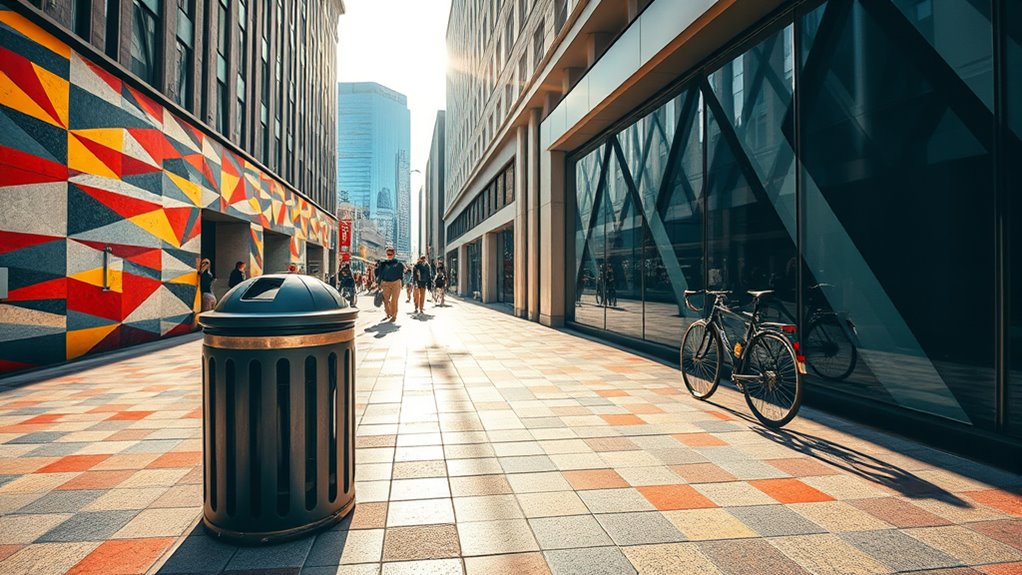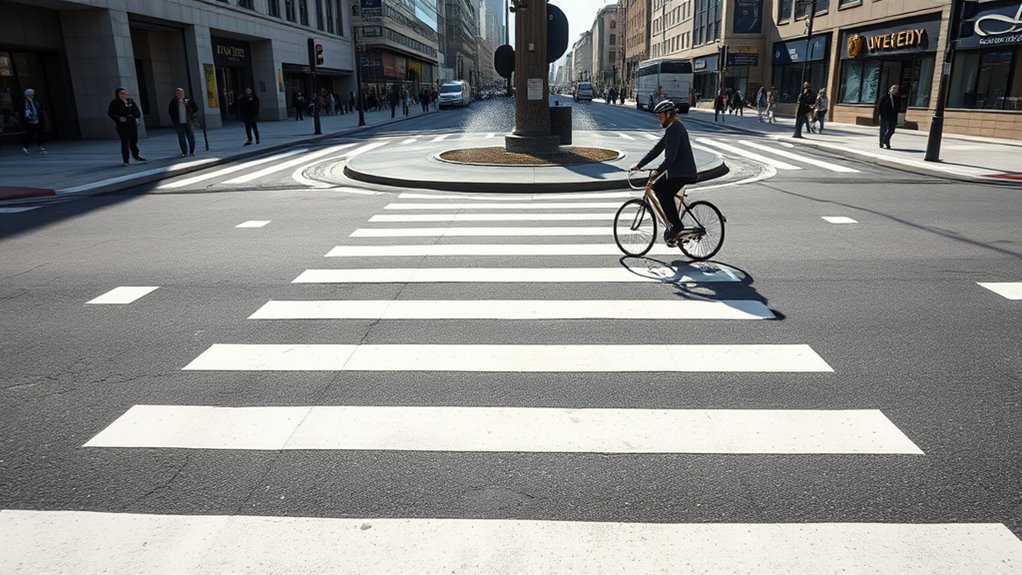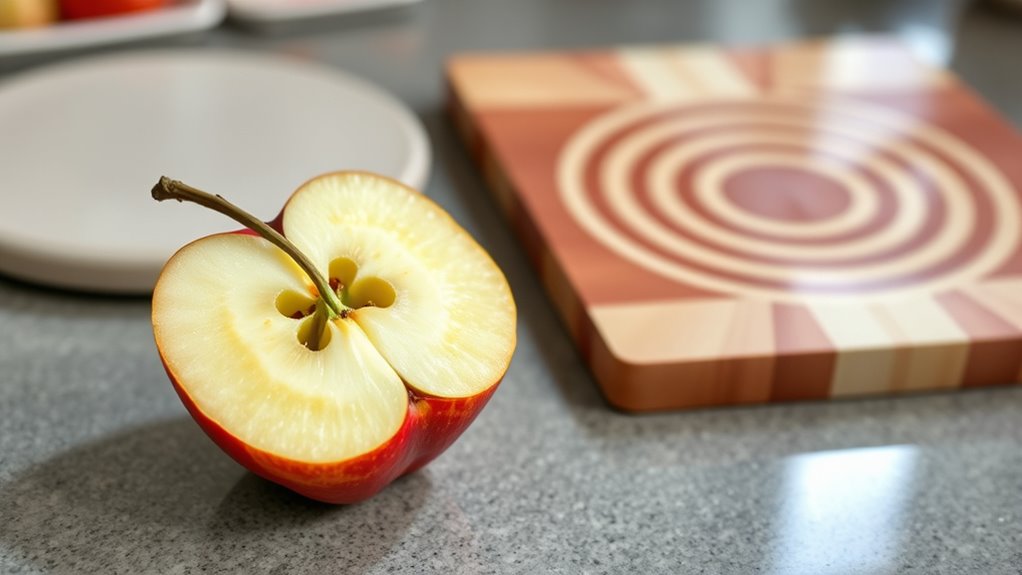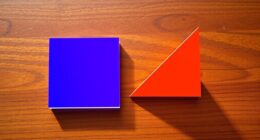You use geometry every day without even noticing it. From recognizing shapes in your surroundings to maneuvering through spaces, your brain constantly applies geometric principles. It influences the design of items you use, helps you find the best way to move, and even shapes the digital world you interact with. Patterns, symmetry, and angles are all around you, subtly guiding your actions. Keep exploring, and you’ll discover how deeply geometry influences your everyday life.
Key Takeaways
- We use geometry when navigating with maps, calculating distances, and determining the best routes.
- Everyday objects like furniture and containers are designed with geometric principles for stability and efficiency.
- Patterns in tiles, wallpapers, and art showcase the use of tessellations and symmetry in daily surroundings.
- Digital screens and virtual environments rely on geometric models to render images and simulate 3D spaces.
- Natural patterns such as snowflakes and leaves demonstrate the presence of fractals and symmetry in nature.
The Shapes of Your Surroundings

The shapes of the objects around you are a direct reflection of geometry in daily life. You notice patterns like mathematical tessellations in tiles and wallpapers, where repeated shapes fit together perfectly without gaps or overlaps. These arrangements showcase how geometry creates harmony in design. Additionally, geometric illusions play tricks on your eyes, making flat surfaces seem three-dimensional or shifting shapes appear to move. These illusions demonstrate how your brain interprets geometric forms differently depending on context and perspective. Recognizing these patterns and illusions helps you see how geometry influences everything from architecture to art. It’s a reminder that the world around you is built on mathematical principles, shaping your environment in subtle, often unnoticed, ways. Understanding geometric principles can enhance your appreciation of everyday design and spatial relationships.
Navigating and Moving Through Space

Have you ever wondered how you effortlessly find your way through crowded streets or navigate a new room? Your brain uses coordinate systems and spatial reasoning to make sense of your surroundings. Imagine these four steps helping you move smoothly:
Our brains use coordinate systems and spatial reasoning to navigate effortlessly through any environment.
- Visualizing a grid overlaying your environment, like a map.
- Using your internal coordinate system to locate objects and landmarks.
- Calculating distances and angles to determine the best path.
- Adjusting your movement based on real-time spatial cues.
- The ability to calibrate and maintain color accuracy ensures your perception of the environment remains consistent and reliable.
These processes allow you to judge where to turn, how far to walk, and when to stop—all without conscious effort. Your brain constantly interprets spatial relationships, helping you navigate confidently through any space. It’s a remarkable application of geometry that’s always at work in your daily life.
Design and Functionality of Everyday Items

Ever wondered how everyday items are designed to work seamlessly for you? It all comes down to the clever use of geometry in their design and functionality. Architects often borrow principles from architectural forms to create sturdy, efficient products, ensuring they fit your needs perfectly. Packaging design, for example, uses geometric shapes to maximize space, protect contents, and make items easy to handle. The shapes and structures are carefully crafted to optimize strength and usability, whether it’s a bottle’s curves or a box’s corners. These geometric considerations make products intuitive, durable, and visually appealing. By understanding how form follows function through geometric principles, designers create items that effortlessly blend practicality and aesthetic appeal, making your daily interactions smoother and more satisfying. Additionally, geometric principles play a crucial role in ensuring the balance and stability of everyday objects.
Technology and Digital Geometry

Modern technology relies heavily on geometric principles to create digital images, 3D models, and virtual environments. When you work with digital algorithms, you use coordinate systems to map points and shapes precisely. These coordinate systems help in positioning objects accurately in space. For example, imagine:
- Pixels on your screen forming a grid, like a city map.
- 3D models built from polygons, fitting together seamlessly.
- Virtual environments created with coordinate points guiding movement.
- Algorithms that analyze angles and distances to render realistic images.
- Understanding the geometry of digital spaces is essential for designing accurate virtual simulations.
Patterns and Symmetry in Nature and Art

Patterns and symmetry are everywhere in nature and art, creating visual harmony that captures our attention. You might notice fractals in art, like intricate snowflakes or fern leaves, where self-similar patterns repeat at different scales. In architecture, tessellations are used in mosaics and tiled floors, fitting together perfectly without gaps. These designs highlight the beauty of symmetry and geometric repetition. To see this clearly, consider the table below:
| Nature Pattern | Artistic Pattern | Architectural Pattern |
|---|---|---|
| Fractals in trees | Fractals in art | Tessellations in architecture |
| Snowflakes | Mandalas | Islamic tile work |
| Fern leaves | Kaleidoscopic designs | Hexagonal honeycomb |
| Spiral shells | Symmetrical sculptures | Geodesic domes |
This shows just how deeply geometry influences our surroundings.
Frequently Asked Questions
How Does Geometry Influence the Layout of City Streets and Urban Planning?
City streets are designed with geometry in mind, shaping the urban grid to optimize traffic flow and accessibility. You notice how straight avenues and grid patterns make navigation easier, preventing congestion. Urban planners use geometric principles to position roads, intersections, and blocks efficiently. This careful layout helps manage traffic, reduce travel time, and improve safety, demonstrating how geometry influences everyday experiences in your city.
Can Understanding Geometry Improve Athletic Performance and Sports Strategies?
Understanding geometry can boost your athletic performance and sports strategies. For example, knowing about angles in dance helps you improve movement precision, while recognizing symmetry in gymnastics enhances balance and form. You can optimize your training by applying geometric principles to refine your techniques, plan better strategies, and prevent injuries. This knowledge allows you to analyze movements and positions more effectively, giving you an edge in your athletic pursuits.
What Role Does Geometry Play in the Development of Medical Imaging Technology?
Like a painter shaping a masterpiece, you see how geometry shapes medical imaging technology. You rely on geometric algorithms to create detailed images of the body, much like a detective piecing clues together. These algorithms help develop MRI and CT scans, allowing doctors to diagnose with precision. Your understanding of geometry directly influences advancements, making these essential tools more accurate and life-saving.
How Do Architects Use Geometry Principles to Ensure Building Stability?
You use geometry principles when designing buildings to guarantee structural integrity and proper load distribution. Architects carefully analyze shapes and angles to create stable structures that can withstand weight and environmental forces. By applying geometric concepts, you optimize material use and prevent collapse. This ensures the building remains safe and durable over time, highlighting how essential geometry is in creating reliable, long-lasting architecture.
In What Ways Does Geometry Contribute to the Design of User Interfaces and Apps?
You rely on geometry when designing user interfaces and apps. It helps you establish a clear visual hierarchy, guiding users intuitively through content. You also use geometric principles to size touch targets properly, making them easy to tap and reducing errors. By applying shapes, alignment, and spacing, you create a balanced, functional design that enhances user experience and guarantees the interface is both attractive and practical.
Conclusion
Just like Da Vinci’s masterpieces, geometry shapes your world in ways you might not notice. Every step you take, every object you use, and the technology you rely on is built with geometric principles behind the scenes. It’s your silent partner, guiding you through life’s puzzles. So next time you see a pattern or a perfect circle, remember—you’re living in a world crafted by the timeless language of geometry, just like a work of art.







